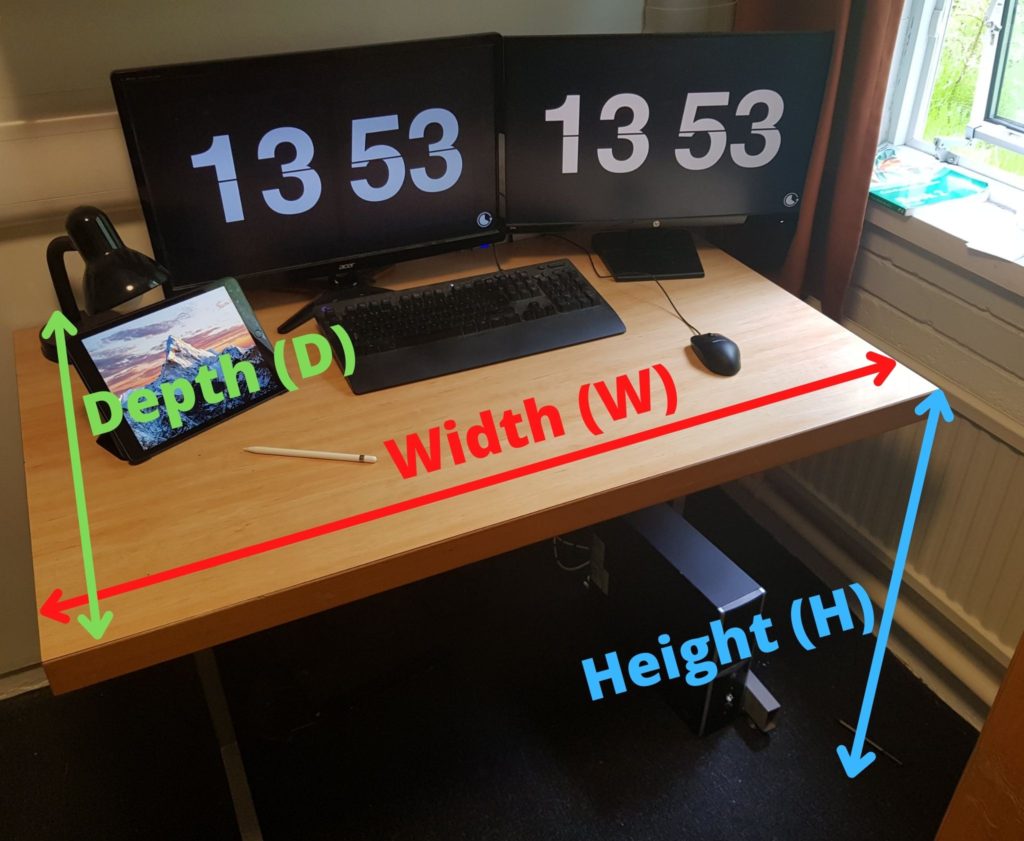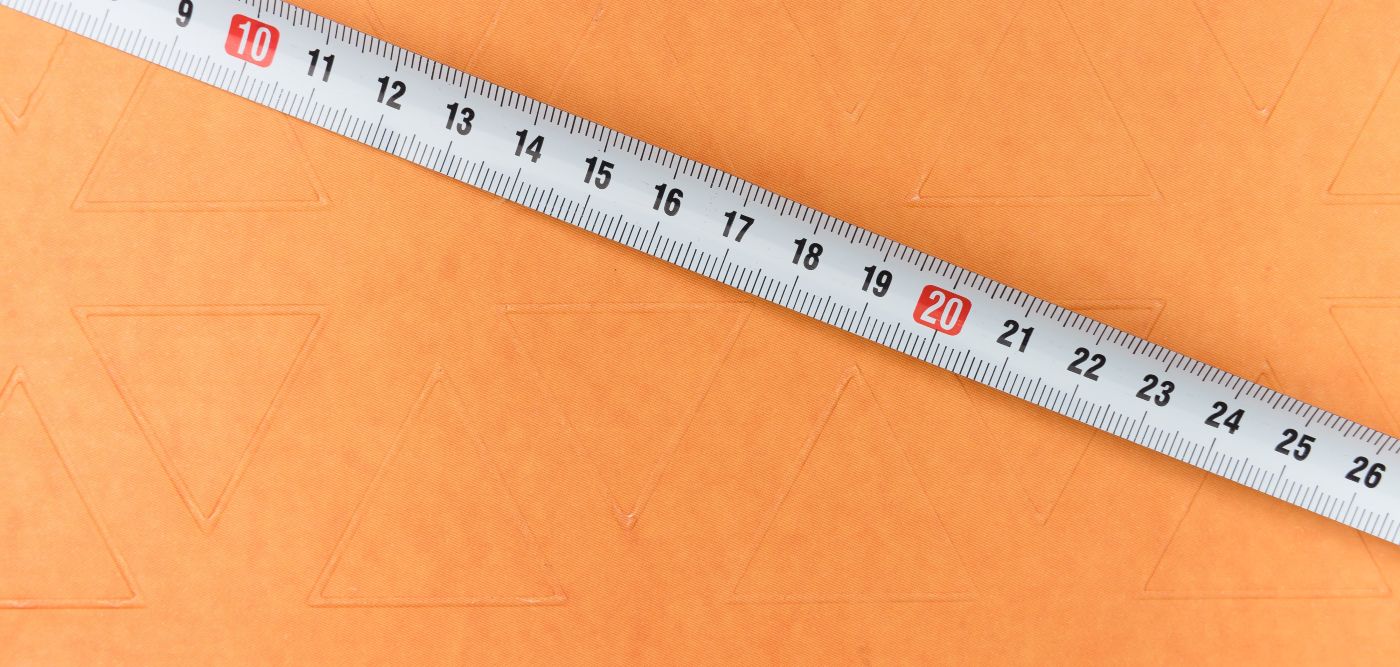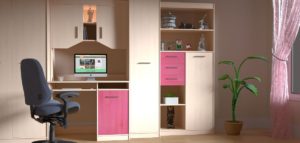A good desk is a foundation any workspace is built upon. In this guide I will take you through all the measurements you will need to ensure your desk fits your space perfectly.
The 3 key measurements to take when getting a desk are width, height, and depth. These are essential to ensure the desk fits your space.
It can be easy to mix these measurements up or even take them from the wrong part of the desk.
Here is my desk with the key measurements labeled.

As you can see from the labels above we call
Depth: The measurement from the front to back edge of the desk. It may help to think of this as ‘how far back the desk goes when you are sat at it’.
Width: The measurement from the left edge to the right edge of the desk, you may think of this being the length of the desk but calling it the ‘width’ is the convention when it comes to desks.
Height: The measurement from the ground to the top of the tabletop.
I’ll break these measurements down more now.
Depth
An average depth is 30inches (76cm), although this can vary quite a bit. One word of advice would be to get a desk with a large depth, I find having a deeper desk really helps me keep my desk clutter free.
Width
Most office desks have a width between 3 and 7feet (60 – 210cm), with 5 feet being a typical width.
The width is the most important measurement, it is essential to make sure you have enough room for your desk and the width is almost always the biggest dimension. Some companies may refer to this as the length of the desk but width is more commonly used.
Height
A standard desk height is in the region of 29inches (73cm). Although, standing and adjustable desks are becoming more common as people try to work in a healthier way. Height adjustable desks usually ditch drawers but it’s still easy to create storage for a drawer-less desk.
One thing to be sure of when you measure height is that you measure to the top of the tabletop. This is very important if the desk you are looking at has a thick tabletop as where you measure from will make a bigger difference.
How To Interpret The Product Dimensions of a Desk
When looking for desks online (including the ones I often recommend) you will often find the dimensions written as something x something x something inches, this can be confusing. Let me clear it up.
Let’s say that for example, you are looking at a desk with dimensions 25x60x47inches. This particular desk would be 25” deep, 60” wide, and 47” tall. So the first number tells you the depth, the second the width, and the third the height.
One thing to look out for is some companies swapping the order of depth, width, and height. What I outlined above is the standard, however, it is helpful to look out for hints to be sure. For example, if you saw ‘60” (W) x 25” (D) x 47” (H)’, then you can see that a different order has been used but you should get the same message.
Here are articles on desks we picked out as they meet the required dimensions for each task:
Desks Specifically for an iMac
Desks Specially Picked for Video Editing
Desks Big Enough For An Ultrawide Monitor and our size guide for ultrawide monitor setups
Desks Just For Medical Students
How To Measure An L-shaped Desk or Corner Workstation

I love Corner desks, I find they give you more space and help enclose you in your work. That’s why they regularly feature at the top of my recommendations for desk. For example in my countdowns of the best desks for Programmers and for ultrawide monitors.
When you have a corner desk it can be a bit more tricky when it comes to taking and interpreting measurements. Often you can find a labeled diagram displaying where the manufacturer is measuring the dimensions from but if not I have a few tips below.
It is common for the dimensions of each segment of the desktop to be given. For example, you will often find a description along the lines of
‘ Tabletop 1: 25×60” Tabletop 2: 25×25” Height: 47” ‘
You can interpret this as a tabletop of depth 25” and width 60” attached to the second tabletop of depth 25” and width 25”, both elevated to a height of 47”. In this case, tabletop 1 and tabletop 2 attach to form an L.
Descriptions of dimensions given by manufacturers of L-shaped or U-shaped can vary, however, it is in their best interest to get the message across to make a happy customer.
If you are still having trouble interpreting the dimensions (or lack of) provided by the seller, a safe bet I recommend is simply contacting them and asking for clarification. Taking this approach avoids any potential mistakes and can make your life a lot easier.
How To Know If A Desk will fit

So you have got your dimensions, now we need to check your desired desk will fit. This is a pretty simple process, measure the space in your room where you envisage locating your desk and check the measurements against the dimensions of the desk.
It is useful to make sure you have a few extra inches of space on top of the desk to be on the safe side. We have some more specific size guides here.
If you are planning on getting a flat-packed desk, that’s the job done!
But if you are buying a pre-built desk you can’t forget to consider the size of any doorways or staircases you will have to move the desk through, most of the time this shouldn’t be a problem but if you are getting a large desk you should definitely check.
The depth of the desk is the measurement you need to keep in mind, if this is less than the width of your doorways then you will be fine, if not then you will either have to disassemble the desk or look elsewhere for your new desk. Here are some methods to help to move in your desk if you are having trouble.
In Conclusion
I hope this guide has solved any queries you might have had when it comes to desk dimensions.
The average desk is 30 in. deep, 60 in. wide, and has a height of 30 in.
Or if you live outside the US
The average desk is 75cm deep, 150cm wide, and has a height of 75cm.
This doesn’t stop there being a massive range of sizes available, which using the guide above you shouldn’t be a problem on your search for your new desk.







